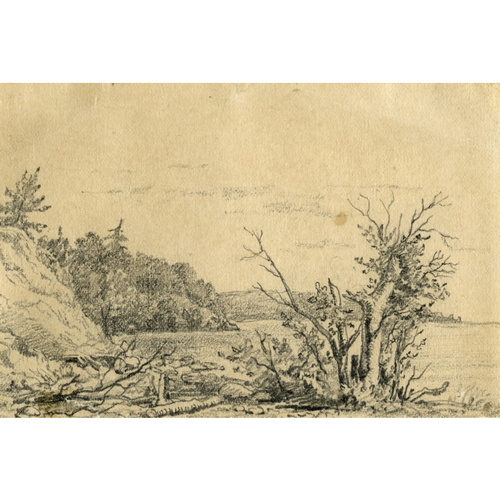WHITE, GEORGE HARLOW, painter; b. c. 1817 in London, England, the son of Elizabeth Harlow, an older sister of artist George Henry Harlow; nothing is definitely known about his father; d. unmarried 18 Dec. 1887 at the Charterhouse, London.
George Harlow White entered the Royal Academy schools, London, on 2 Jan. 1836; his address was given as the Charterhouse, where his mother was under-housekeeper, and he was recommended by Henry Sass at whose school, considered a preparatory school for the academy, he probably studied. Unfortunately there are no records of students’ progress at the academy school. Early works exhibited in England included portrait studies, and there is some evidence that he worked as an illustrator. His main interest, however, in true Victorian fashion, developed towards picturesque landscapes and in this tradition he worked in Scotland, Ireland, Wales, and the Home Counties between 1839 and 1871.
On 17 Sept. 1871 the Prussian arrived in Quebec from Liverpool, carrying a “Geo H White, male, single, age 50, occupation labourer.” The record of his six years in Canada is based almost entirely on hundreds of small pencil drawings and some watercolours, most of them meticulously dated, titled, and signed in his own hand. It has been stated that he bought a bush farm in Oro Township, Ont., but there is no documentary evidence to support the statement, although his sketches indicate that his home base was there, and that Shanty Bay was his earliest address in Canada. He probably lived with George Street, a freeholder in Oro from 1871 with a residence in Barrie from 1875. White’s drawings and water-colours reveal a concentration of work in Simcoe County (Oro and Vespra townships and Barrie) in 1873 and 1874, with visits in the summer to the Muskoka region. In 1874 and 1875 he visited the Owen Sound area and returned to the Muskoka region where he produced about 70 sketches in the Huntsville area. In 1876 his travels extended to Ottawa, Quebec, and the St Lawrence–Lake Ontario region, and then, apparently, to the west of Canada. His western sketches, about 20 in all, are, unlike his other work, not dated and inscribed by the artist. They are catalogued, in the John Ross Robertson Collection at the Metropolitan Toronto Library, with place names such as Peace River and Fort Dunvegan (Dunvegan, Alta), and Yellowhead, Robson Peak, Savona’s Ferry (Savona), Kamloops, Lytton, Salmon Cove, and Skeena River, B.C. Although they are all listed as October 1876 it is highly unlikely that White was able to visit and sketch all these places in one month. Studies of forests, lakes, trees, and pioneer life in the bush, as well as street and waterfront scenes of topographical and historical interest, comprise his modest contribution to the visual record of 19th-century Canada.
White was elected a member of the Ontario Society of Artists in March 1873 and continued to exhibit with the society until 1886. The majority of works he submitted were water-colours of British subject matter and in this respect he was no exception: Victorian taste, as manifested in Canada, found its standards in Britain, and picturesque landscape with romantic overtones dominated Canadian exhibitions. White was also a prolific exhibitor with the Art Association of Montreal (later Montreal Museum of Fine Arts) and with the Royal Canadian Academy, even after his return to England some time in 1877 (on 18 Sept. 1877 he was appointed a “poor brother” at the Charterhouse in London on the recommendation of Lord Chelmsford). In 1880, at the first annual meeting of the Canadian Academy of Arts (after 19 Aug. 1880 the Royal Canadian Academy of Arts), White was elected an honorary non-resident academician and Lucius Richard O’Brien* of Shanty Bay the first president.
Harlow White brought with him the English tradition of drawing and painting as an observant lover of nature. His experience in Canada made no marked change in his style and his major paintings continued to be of British landscapes, including even his Royal Canadian Academy diploma painting, The River Conway, North Wales, dated 1885. John William Harrell Watts*, first curator of the National Gallery of Canada, made this observation about him: “met him at time of the Colonial Exhibition [in London in 1886] and found him to be a fine genial old gentleman . . . .”
[A list of institutions which hold works by George Harlow White is contained in Harper, Early painters and engravers. Other works by White are held in the PAC, in the Art Gallery of Hamilton (Hamilton, Ont.), and in various private collections. f.k.s.]
Agnes Etherington Art Centre, Queen’s Univ. (Kingston, Ont.), G. Harlow White corr. and catalogue raisonné records. Montreal Museum of Fine Arts, Reference Library, ms Watts. Art Gallery of Ontario: the Canadian collection (Toronto, 1970). George Harlow White, RCA, 1817–1887 . . . , comp. F. K. Smith ([Kingston, 1975]). Landmarks of Canada; what art has done for Canadian history . . . (2v., Toronto, 1917–21; repr. in lv., 1967),I. National Gallery of Canada, Catalogue of paintings and sculpture, ed. R. H. Hubbard (3v., Ottawa and Toronto, 1957–60), III. A. H. Robson, Canadian landscape painters (Toronto, 1932). F. K. Smith, “A Victorian artist in Canada: George Harlow White, RCA, 1817–1887,” Canadian Collector (Toronto), 12 (1977), no.2: 40–43.
Cite This Article
Frances K. Smith, “WHITE, GEORGE HARLOW,” in Dictionary of Canadian Biography, vol. 11, University of Toronto/Université Laval, 2003–, accessed August 15, 2025, https://www.biographi.ca/en/bio/white_george_harlow_11E.html.
The citation above shows the format for footnotes and endnotes according to the Chicago manual of style (16th edition). Information to be used in other citation formats:
| Permalink: | https://www.biographi.ca/en/bio/white_george_harlow_11E.html |
| Author of Article: | Frances K. Smith |
| Title of Article: | WHITE, GEORGE HARLOW |
| Publication Name: | Dictionary of Canadian Biography, vol. 11 |
| Publisher: | University of Toronto/Université Laval |
| Year of revision: | 1982 |
| Access Date: | August 15, 2025 |










